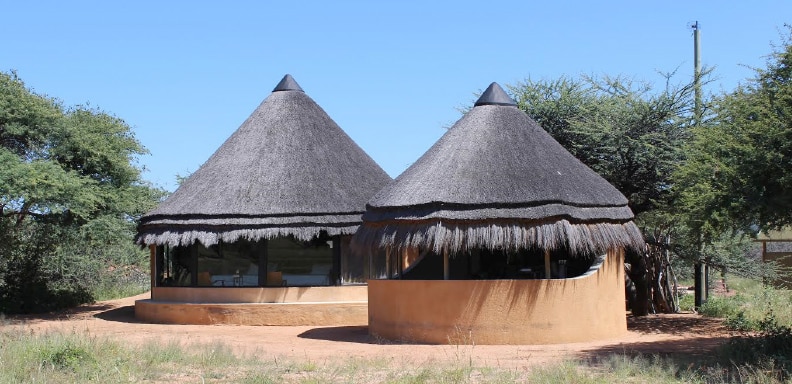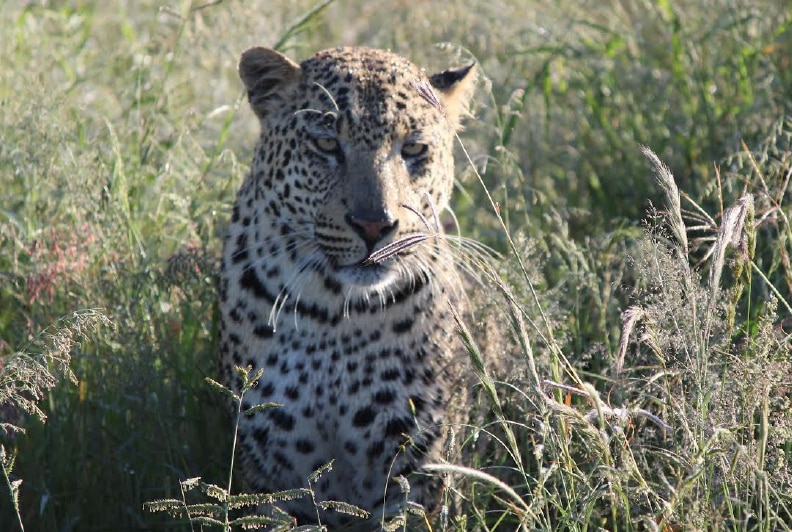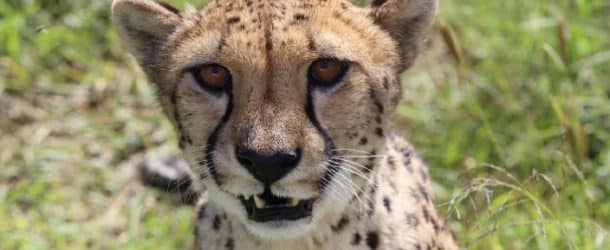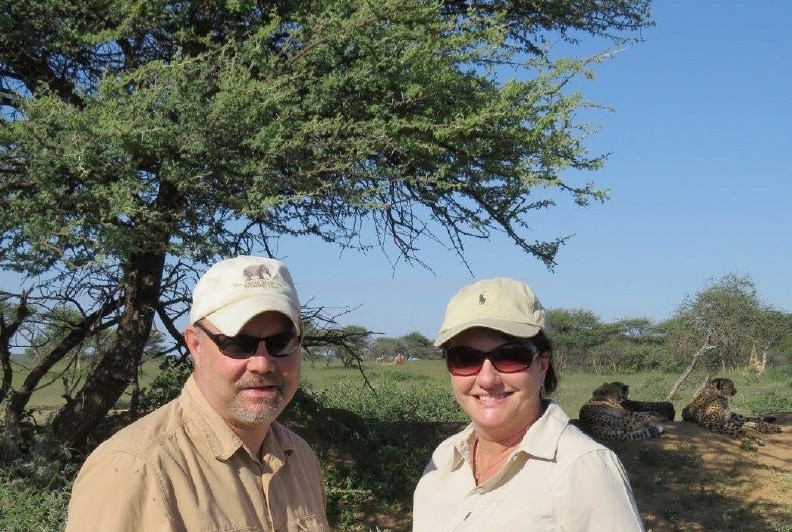A Passion For Saving Wildlife Leads Lake Charles Natives Into The African Bush
By Lydia Crochet
Around the world, animals are losing their habitats and their lives due to environmental degradation. Some species are even becoming extinct. Volunteers are needed to help work on wild animal rescue centers and reserves, with research and tracking and with providing education about animal trafficking and protection. Lake Charles natives Lt. Col. (US Army Retired) Brian Johnson and his wife, Kitty, are passionate about this kind of work, and spend their free time traveling in Africa, where they volunteer to help conserve the wildlife they love so much.
Elephants, in particular, have benefitted greatly from the Johnsons’ efforts. This magnificent creature is vital to the web of life in Africa. As a keystone species, elephants help balance all the other species in their ecosystem by opening up forest land to create firebreaks, digging to create water access for other animals, and leaving nutrients in their wake. Sometimes called the “mega gardeners of the forest,” elephants are essential to the dispersal of seeds that maintain tree diversity.
Despite a ban on the international trade in ivory, African elephants are still being poached in large numbers. Tens of thousands of elephants are being killed every year for their ivory tusks. In 2015, the Johnsons spent several weeks in Kenya’s Masaai Mara, collecting data on lions, elephants and other species to assist researchers in determining the health of animal populations in the area.
That same year, Brian literally took the high road by leading a team to the summit of Mt. Kilimanjaro, Africa’s highest mountain at 19,341 feet, to raise funds for Save the Elephants, a Kenyan-based organization dedicated to ensuring a future for the elephant. Because this effort was such a success, he’s decided to do it again. In 2018, Brian will be leading a band of adventurers up Mt. Kenya in Kenya, then on to conquer Mt. Stanley in Uganda to raise even more funds for the elephants.

I recently caught up with Brian to ask about their visit to cheetah conservation. What follows is his account of the couple’s adventure:
My wife and I have always been intrigued by Namibia, the former German colony in southwest Africa. Its remote location, sparse population and reputation as an adventurer’s paradise have always attracted us. So it was convenient that a conservation project we are working on would take us there. Namibia is a real “tough guy” country bordered by Angola, Botswana, Zambia and South Africa.
The country’s infamous Skeleton Coast stretches north to Angola, and is littered with the wrecks of hundreds of ships which broke apart on its shoals. The Bushmen of Namibia referred to the area as “The Land That God Made in Anger,” while Portugese sailors referred to it as “The Gates of Hell.”
We landed at the international airport outside the capital city of Windhoe. The airport is small by international standards, but welcoming and warm. I like African airports, because they are loud and vibrant, so unlike the sterile airports of the West.
The arrival area was filled with sun-deprived Europeans decked out in safari wear for their first trip to Africa. I was jealous of them in a way, remembering the quote “The only man I envy is the man who has not yet been to Africa, for he has so much to look forward to.” I recalled my first time in Africa, and smiled as I passed the chattering throng lined up at the currency exchange, so eager to begin their journey.
After being told our rental truck was not ready to pick up, we ordered coffee and settled in for a long wait, because Africa hurries for no one. Finally getting our truck, we set off for Windhoek with the windows down, music blaring and smiles on our faces, happy to be back on the continent again.

A woman from Stuttgart, Germany greeted us at our hotel, and we talked about our years of living in her country when I was a soldier. The ghosts of Imperial Germany still linger in this dusty and remote part of the world.
We set off the next morning for Swakopmund, the port city founded to serve Deutsche Sudwestafrika (German Southwest Africa), as Namibia was called when it was Berlin’s colony.
As we neared “Swap,” the terrain changed from arid brush grassland to sand, and we entered the Namib Desert, believed to be the oldest desert in the world. The Namib stretches from Angola in the north and skirts south along the Namibian coast.
We spent two days with friends in Swap, wandering the streets, sitting in cafes and browsing second-hand bookstores. We stayed at an Airbnb home on the ocean, and prepared a braaivleis, Afrikaner for grilled meat, while we sat on the second-floor patio, sampled local beers and watched the fog roll in off the Atlantic.

All around us, freighter ships under Russian, Nigerian, Angolan and Singaporean flags were anchored offshore awaiting repairs or taking advantage of the cheap anchorage fees Namibia charges maritime companies.
It was a great couple of days along the coast, but it was time to get to the bush.
We departed the next day for Cheetah Conservation Fund (CCF) in Otjiwarango. CCF, an organization we have supported in the past, is the global leader in cheetah research and conservation. Last year, I worked on a project with Action For Cheetahs In Kenya, a CCF-affiliated non-profit organization to train dogs to detect cheetah scat in the field. This will assist researchers in determining the number of remaining cheetahs in Kenya, as well as determine their current ranges.
We spent a week working with the dogs, and then deployed to Kenya’s remote northern Samburu district to test them in the field. It was an interesting time spent with the dogs, which are another innovative tool being used to ensure the survival of cheetahs.

An estimated 100,000 cheetahs once ranged across Africa and into India, but less than 8,000 remain in the wild today. With humans encroaching on their historic ranges, cheetahs often come into conflict with farmers, who kill them when the cats threaten their livestock. An innovative program being run by CCF is the Livestock Guard Dog Program, which places Anatolian shepherds with farmers, who rely on the large dog’s intimidating presence to frighten off cheetah predators.
Research indicates the program is effective, significantly reducing livestock losses due to cheetah predation.
Smuggling of cheetah cubs for sale as pets is also a factor in the decline of the cheetah population. It is estimated that only one out of every six cubs smuggled out of the wild survives the journey. CCF is active in combating the illegal wildlife trade, and is a founding member of the Coalition Against Wildlife Trafficking.
We met some wonderful people at CCF, all dedicated to ensuring the cheetah’s survival. We toured the organization’s genetics lab, where research is being conducted on the health of the cheetah population, and soaked up all we could about the illegal trade of cubs, a project I am collaborating on with several people. As I write these words, a friend is assisting in the rescue of 10 cheetahs in Somaliland — a small victory in the war against wildlife trafficking.
Our afternoons were spent in the Waterberg Conservancy, where thousands of Oryx and Springbok grazed on the savannah. Warthogs were everywhere, running across the savannah with their tails straight up in the air as their babies struggled to keep up with their little stubby legs. And, of course we had our nightly sundowners with gin and tonics while being serenaded by the greatest symphony in the world — the sounds of the bush.
We left CCF and headed south to Okonjima, home of the AFRICAT Foundation. AFRICAT’s mission is the long-term preservation of Namibia’s carnivores — animals such as the leopard, cheetah and lion.
The founders of AFRICAT cleverly structured the organization. The group’s work is partially funded by guests who stay at lodges built there on the 22,000-hectare reserve. We checked in and instantly fell in love with the place.
Our room was a circular stone hut with a thatched roof built under acacia trees on the savannah. A separate open-air day hut was attached, where we could lie on day beds and watch the wildlife. I tend to wake up very early in the bush to watch the sun rise and have coffee. On this trip, I had a companion every morning, a big warthog I named Warty. He would snort and root around during his visits, until he grew bored and wandered off into the tall grass, no doubt to attend to important warthog matters. He was a colorful little character, and I thoroughly enjoyed his visits.
Our afternoons were spent on game drives in the reserve. One afternoon, we spotted a young leopard, lying perfectly camouflaged in the bush. After a few minutes, he grew annoyed with our presence, glared in our direction and silently walked off into the bush.
The leopard is the “cool guy” of the African big-cat world — mysterious and aloof. Preferring obscurity, they hunt at night in the shadows of tree-lined rivers or brush-covered hills. I’ve seen a few leopards in my travels, and they never fail to amaze me with their stealth and beauty. They are haughty, as they gaze upon us humans with utter contempt and grudging toleration. They’re never to be trusted or taken for granted. I’m in awe of the lion, but there is something eerie about the leopard, the shadow assassin of the bush.
One of Africa’s most threatened predators is the African Wild Dog, an animal we had never seen before this trip. The AFRICAT Foundation is attempting to reintroduce wild dogs back into the wild and maintain a pack on the reserve for eventual release.

They slowly and deliberately circled our vehicle, ducking in and out to see how far they could test some imaginary boundary between us. They are lanky creatures with beautifully colored pelts and large ears with faces resembling a German shepherd’s. It was a great experience to see one of Africa’s most unique species.
Our last night was spent with two male lions rescued by the foundation after their mother was killed in northern Namibia. We entered a concrete “hide” site and awaited the lion’s arrival. After several minutes, two beautiful lions with flowing golden manes ran towards us through the long grass, growling and roaring loudly. I’ve heard the roar of lions from miles away, but it was a totally different experience being so close. We literally felt the sound vibrations reverberate through our bodies.
We spent an hour in the hide site, watching these magnificent animals, discussing conservation and watching a beautiful sunset. It was an incredible end to another African adventure.
That night, Kitty and I shared our 25th wedding anniversary with new friends from Amsterdam. We talked for hours about our lives abroad as the wine bottles piled up on our table.
I am writing these words in my bush hut late at night. Outside, a cool breeze is blowing ever so lightly across the moonlit savannah, gently rustling the tall grass. My wife is asleep, and I am alone with my thoughts. I think about how fortunate I am to live this nomadic life of adventure, and to be married to someone who loves it as much as I do.
I’ve lived in five countries, and drank in bars from Norway to South Africa, and from Ireland to points east in Asia. I’ve watched the sun rise from atop Mt. Kilimanjaro in Tanzania, been charged by elephants in Kenya, camped in the Arabian Desert, marveled at the Hindu Kush Mountains in Afghanistan, and made lifelong friendships with people from every corner of the world.
I glance over at my sleeping wife, and I know I am the luckiest guy in the world. I wouldn’t trade my life with anyone for any amount of money.
When the day arrives to embark on the biggest adventure of all, I want my headstone to simply read “He lived.” I turn off the light and fall asleep to the sounds of the bush.
The Johnsons maintain homes in Lake Charles and Saudi Arabia, where Brian has worked for the past four years as a security management professional. They are members of the East African Wildlife Society, the African Wildlife Foundation and several other conservation organizations. They share their homes with several rescue cats, and a large rescued Shepherd named Milo.
As for the Johnson’s next adventure, Brian admits he wouldn’t mind going on a snake safari in East Africa to photograph cobras, mambas and other reptiles. This particular endeavor is not on Kitty’s bucket list, and she wishes her husband well on his solo reptile escapade. In fact, when asked about said adventure, Kitty didn’t mince her words. Who knew the word “no” could be used in so many forms?
As for now, she aspires to continue her work with elephants, large cats, small cats and anything else that doesn’t slither.
If you would like to help with wildlife conservation, go to savetheelephants.org, cheetah.org or actionforcheetahs.org.

















Comments are closed.